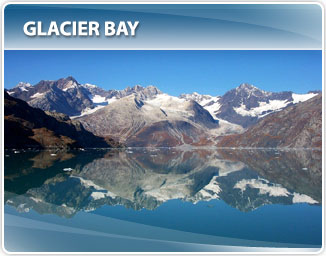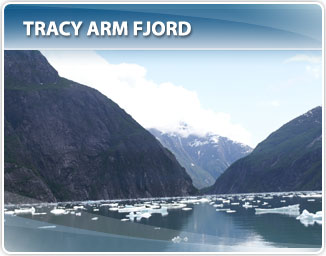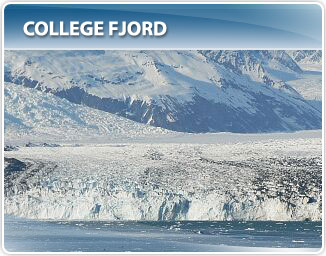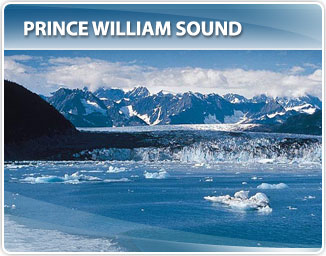


Glacier Bay National Park
|
|
 |
How does it feel when a monumental chunk of ice splits off a glacier and crashes into the sea? The sound is like thunder. The impact shoots water hundreds of feet into the air. You hold your breath as you catch the moment on film. Then you wait for it to happen again. And it does. Glacier Bay has more active calving glaciers than anywhere else in the world. Cruise by Reid and Lamplugh glaciers to the mighty John Hopkins - surrounded by rugged peaks and sheltering a seal pupping ground. Linger at Grand Pacific and Margerie glaciers for the grandest spectacle of them all. Margerie is an Ice Age giant a mile wide and 25 stories high. You will marvel at nature's unrelenting power as you witness the birth of one massive iceberg after another. Wildlife Search for humback whales returning from their wintering grounds near Hawaii, killer whales feeding in the park's near-shore waters, Steller sea lions resting on rocky islands, and harbor seals nurturing their pups. Glacier Bay is the setting for an unforgettable wildlife search. |
Hubbard Glacier
|
|
 |
Stand in awe before Alaska's most massive tidewater glacier. This dazzling ice-blue behemoth fills your view and extends for miles at either side. It originates on the slopes of Mt. Logan 76 miles away in Kluane National Park, and spreads across a valley 40 miles wide. By the time it reaches Disenchantment Bay, its architecture towers 40 stories high, dwafing even the largest cruise ships. Nicknamed the "Galloping Glacier," Hubbard moves faster than almost any other glacier on the continent. It advanced so fast in 1986 it dammed Russell Fjord. And now it threatens a repeat performance. As your ship sails along its looming mass, listen for the loud, deep rumble. Wait for the mighty crack and the thunderous crash. Then marvel as icebergs the size of large buildings crash into the sea. |
Tracy Arm and the Twin Sawyer Glaciers
|
|
 |
This narrow, 26-mile-long fjord is another of Alaska's most dramatic glacier settings. Stand out on deck as the lush rain forest recedes and you enter a stunning canyon of bare rock. The panorama of 7,000-foot mountain peaks and nearly vertical rock cliffs is astounding. Countless waterfalls appear at every turn. Icerbergs make their way to the sea in all sorts of wondorous shapes. And tucked away at the end of this remarkable waterway are two very active reminders of the Ice Age - the twin Sawyer Glaciers. The face of South Sawyer Glacier stretches one-third of a mile and calves icebergs big and small. Hundreds of harbor seals dot the floating platforms. Kittiwakes and mountain goats are a common sight. Whales and bears may even make an appearance in this magical place where closeness and intimacy make you part of the scene. |
College Fjord
|
|
 |
Only one place in Alaska surrounds you on all sides with tidewater glaciers. Withing the dramatic setting of this narrow fjord, sparkling blue glaciers flow to the sea. One after another, glaciers named Princenton, Yale, Bryn Mawr and Vassar line up to starboard and port. At the head of the fjord lies Harvard Glacier. Here you'll linger for an in-depth lesson on nature's power. You'll be following in the wake of an illustrious group funded by railroad magnate Edward H. Harriman that traveled here in the summer of 1899. This scientific expedition found the mother lode of Ice Age glory - the greatest density of tidewater glaciers in Alaska - and returned with over a hundred trunks of specimens and thousands of photographs and color illustrations. |
Mendenhall Glacier and the Juneau Icefield
|
|
| Embark on a trip back in time during a visit to the Juneau Icefield. Located in the Coast Mountain Range, North America's fifth largest icefield blankets over 1,500 square miles of land, and stretches nearly 85 miles north to south and 45 miles east to west. It feeds 38 large glaciers, including the Mendenhall, on the road system just north of Alaska's capital city, Juneau, and the Taku, the largest, visible only by boat or plane. The Juneau Icefield is a massive accumulation of ice and snow stretching from upper Taku Inlet north to Skagway. Scientists estimate the icefield's snow and ice depth to be from 800 to over 4,500 feet (245 to 1371 meters). It lies around peaks called nunataks which push through the ice. Devil's Paw, the icefield's highest peak, straddles the Alaska-Canada border and stands 8,584 feet (2616 m) tall. Like a parent, the Juneau Icefield sends its offspring down from the heights to find their way inexorably down between the peaks in the many glaciers it feeds. |
|
Columbia Glacier
|
|
 |
The largest tidewater glacier in Prince William Sound and the second largest in the entire state of Alaska, Columbia Glacier is 25 miles from Valdez and covers more than 400 square miles. It encompasses a magnificent region of over fifteen thousand miles of water, ice and mountains. The face is more than 3 miles wide and is rapidly moving backward at a rate of 4 feet per day in the summer. The Sound’s clear seawaters produce a rich marine life. Spot porpoises, killer whales, humpback whales, seals, sea lions, eagles and otters. |
Portage Glacier
|
|
|
One of the most spectacular sights in Alaska is glacier calving, when massive chunks of ice break away and plunge into the water. And one of the very best places to witness calving is Portage Lake, located an hour south of Anchorage just outside of Girdwood. Here, Alaska's second most visited attraction is just a boat ride away: mighty Portage Glacier. |
|
ALASKA CRUISES AND LAND TOURS by CEALS
a division of Corporate Events and Leisure Services LLC (CEALS)
Washington Seller of Travel License # 603-078-647
Find an Alaska Cruise - Alaska Cruises - Alaska Cruisetours Cruise from Seattle Cruise from Vancouver BC Inside Passage cruises Gulf of Alaska cruises